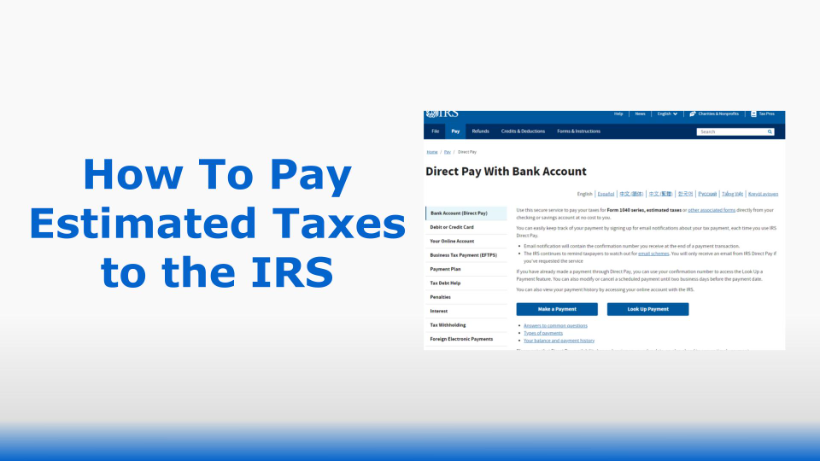How to Write a Check to the IRS for Taxes
Published:Individuals have many different options for paying their federal income taxes. You can pay electronically (online) with a credit card, debit card, or e-check (electronic check). Or you can pay your taxes by paper mail with a check, money order, or cashier’s check. Additionally, if you wish to pay in cash, there is an option for that as well.
Electronic Payment Options
Electronic payment options give taxpayers the opportunity to pay their taxes online, as an alternative to sending in a check or money order. Online payments can be made 24 hours a day and 7 seven days a week. Additionally, these electronic payment options are safe, secure, and easy to use.
Individuals who are using IRS e-file to file their tax return can authorize a payment through Electronic Funds Withdrawal (EFW), use a debit or credit card, or enroll in the U.S. Treasury’s Electronic Federal Tax Payment System (EFTPS). Both the EFW and the EFTPS options are free of charge.
Payments by Check, Money Order, or Cashier’s Check
If you are making a tax payment by check, money order, or cashier’s check, be sure that it’s made payable to the ‘United States Treasury’ (or ‘U.S. Treasury’). Write your Social Security Number (or Employer Identification Number), the tax period, and the related tax form number on your check or money order. Finally, make sure to mail the payment to the correct address, as listed on your tax notice or tax form instructions.
Cash Payments
Note that cash payments can only be made in person at a local IRS Office — do not send a cash payment for your taxes through the mail! You can check the IRS website for office locations throughout the country.
Late Payments
Whether you are filing late and/or paying late, the IRS urges taxpayers to pay their bill in full. It is always recommended that you pay as much of what you owe as you can, and as soon as you can. The longer you wait, the more late fees and interest charges that can accrue.
According to the IRS, ‘If taxes are not paid, and no effort is made to pay them, the IRS can ask a taxpayer to take action to pay the taxes, such as selling or mortgaging any assets owned or getting a loan. If effort is still not made to pay the bill, or make other payment arrangements, the IRS could also take more serious enforced collection action, such as levying bank accounts, wages, or other income, or taking other assets. A Notice of Federal Tax Lien could be filed that may have a detrimental effect on a taxpayer’s credit standing.’
Penalties, Late Fees, and Interest Charges for Paying Late
If you don’t pay your income taxes by the deadline (typically April 15th), the IRS will most likely assess a late payment penalty and interest charges which accumulate each month that your taxes go unpaid.
The ‘late payment penalty’ is usually 0.5% of the unpaid taxes, assessed on a monthly basis. For example, if you have $2,000.00 in unpaid taxes, the IRS may charge you $10.00 per month as a late payment penalty: $2,000.00 x 0.5% = $10.00
If you haven’t paid your balance by the time your tax return is due, you will begin to accumulate ‘interest charges’ on your outstanding balance. This interest is typically assessed at 5.0% annually on your balance.
For example: If you filed a tax extension but did not pay the taxes due, you will be charged 5.0% interest annually (or 0.4% interest monthly) on your outstanding balance. Using numbers from the example above, let’s assume $10.00 per month in late payment penalties. Add to that your monthly interest charge of 0.4%, which is about $8.00 per month in interest: $2,000.00 x 0.4% = $8.00
IRS PAYMENT PLANS
If you cannot pay the full amount due with your income tax return, you can ask the IRS if they will allow you to make monthly installment payments for the full amount or a partial amount. However, keep in mind that you will be charged interest and also possibly a late payment penalty on the tax not paid by the date your return is due, even if your request to pay in installments is granted.
If your payment plan request is granted by the IRS, you must also pay a fee. To limit your interest and penalty charges, try to pay as much of the tax as possible with your tax return. But before requesting an installment agreement, you may want to consider other less costly alternatives, such as a bank loan.
To ask for an installment agreement, use Tax Form 9465, known as the Installment Agreement Request. You should receive a response to your request within 30 days. You can also apply online for a payment agreement. To do that, go to the IRS website and use the pull-down menu under ‘I need to . . .’ and select ‘Set Up a Payment Plan.’
How an Installment Agreement Works
The IRS will usually let you know within 30 days after receiving your request whether it is approved or denied. However, if your request is for tax due on a return you filed after March 31, it may take longer than 30 days to reply. If The IRS approves your payment plan request, they will send you a notice detailing the terms of your agreement and requesting a fee of $105 (or $52 if you make your payments by electronic funds withdrawal). However, you may qualify to pay a reduced fee of $43 if your income is below a certain level. The IRS will let you know whether you are eligible for the reduced fee. If the IRS does not say you qualify for the reduced fee, you can request the reduced fee using Tax Form 13844 (Application for Reduced User Fee for Installment Agreements).
You will also be charged interest and possibly a late payment penalty on any tax not paid by its original due date, even if your request to pay in installments is granted. Interest and any applicable penalties will be charged until your balance is paid in full. To limit the interest and penalty charges, you will want to file your tax return on time and pay as much of the tax as possible with your return (or notice). All payments received will be applied to your account.
By approving your request, the IRS agrees to let you pay the tax you owe in monthly installments (instead of immediately paying the amount in full). In return, you are agreeing to make your monthly payments on time. You are also agreeing to meet all your future tax liabilities. This means that you must have enough withholding or estimated tax payments so that your income tax liability for future years is paid in-full when you timely file your return. Your request for an installment agreement will be denied if all required tax returns have not been filed. Any tax refund due you in a future year will be applied against the amount you owe. If your tax refund is applied to your balance, you are still required to make your regular monthly installment payment.
Installment Payment Methods
You can make your payments by check, money order, credit card, or with a different payment method. After The IRS receives each payment, they will send you a notice showing the remaining amount that you owe, and the due date and amount of your next payment. However, if you choose to have your payments automatically withdrawn from your bank account, you will not receive these notices in the mail.
Keep in mind, your bank statement is your record of payment. The IRS will also send you an annual statement showing the amount you owed at the beginning of the year, all payments made during the year, and the amount you owe at the end of the year. If you do not make your payments on time, or you do not pay any balance due on a return you file later, you will be considered ‘in default’ on your installment agreement and the IRS may take action against you ? such as filing of a ‘Notice of Federal Tax Lien’ or an IRS levy action ? to collect the entire amount you owe. To ensure that your payments are made in a timely manner, you should consider making them by electronic funds withdrawal.
MAKING A PAYMENT WITH YOUR TAX EXTENSION
Before you complete your tax extension request, remember this important fact: a tax extension gives you more time to file your income tax return (e.g., Tax Form 1040), but it does not give you more time to pay any tax that you owe to the IRS. So if you owe the IRS money, you are expected to pay that full amount by the original deadline (typically April 15th) or else you may be subject to penalties and late fees.
There are several ways to make payments with your tax extension. Here is a summary of the main payment options:
Electronic Funds Withdrawal (EFW) Payment
If you e-file taxes online, using your personal computer or through a tax extension professional (like FileLater), you can make a payment by authorizing an Electronic Funds Withdrawal (EFW) directly from your bank account. Make sure to check with your financial institution to confirm that an electronic funds withdrawal is allowed, and to obtain the correct routing and account numbers. If you owe income tax and wish to have the money electronically withdrawn from your bank account, you will be asked to agree to the following declaration:
“I authorize the U.S. Treasury and its designated Financial Agent to initiate an ACH electronic funds withdrawal entry to the financial institution account indicated for payment of my federal taxes and the financial institution to debit the entry to this account. To revoke a payment, I must contact the U.S. Treasury Financial Agent at 1-888-353-4537 no later than 2 business days prior to the payment (settlement) date. I also authorize the financial institutions involved in the processing of the electronic payment of taxes to receive confidential information necessary to answer inquiries and resolve issues related to the payment.”
The EFW payment option allows taxpayers to e-file their 4868 Form online and simultaneously ‘e-pay’ the tax that they owe. You will receive a written copy of the EFW payment authorization once you complete the transaction. It is important to keep this for your records. If you e-file your tax extension, do not send in a paper Form 4868.
Credit Card Payment
You can apply for a tax extension by paying (part or all of) your income tax by credit card. To pay using a credit card, you will need to go through an IRS-approved service provider ? Link2Gov Corporation, RBS WorldPay, or Official Payments Corporation. Phone numbers and sites for the service providers are available on the IRS website.
You can use your American Express®, Discover®, MasterCard®, or Visa® credit card. A convenience fee will be charged by the service provider based on the amount you are paying. Note that fees may vary among the providers. You will be told what the fee is during the payment process, and you will have the option to either continue or cancel the transaction. You can also find out the fee amount be by calling the service provider’s customer service number or by visiting their website. Do not add the convenience fee onto your tax payment.
When you make a tax extension payment by credit card, you will receive a confirmation number. Make sure to save this number for your records.
Payment by Check or Money Order
When paying by check or money order, mail your payment with Tax Form 4868 to the appropriate address (listed on the Instructions for Form 4868). Make your check or money order payable to the “United States Treasury” and DO NOT SEND CASH. Also don’t forget to write your Social Security Number, daytime phone number, and the words “2011 Form 4868” on your check or money order. Do not staple or attach your payment to Tax Form 4868. Additionally, if you e-file Form 4868 online and mail a check or money order to the IRS for tax payment, use a completed paper Form 4868 as a payment voucher.



